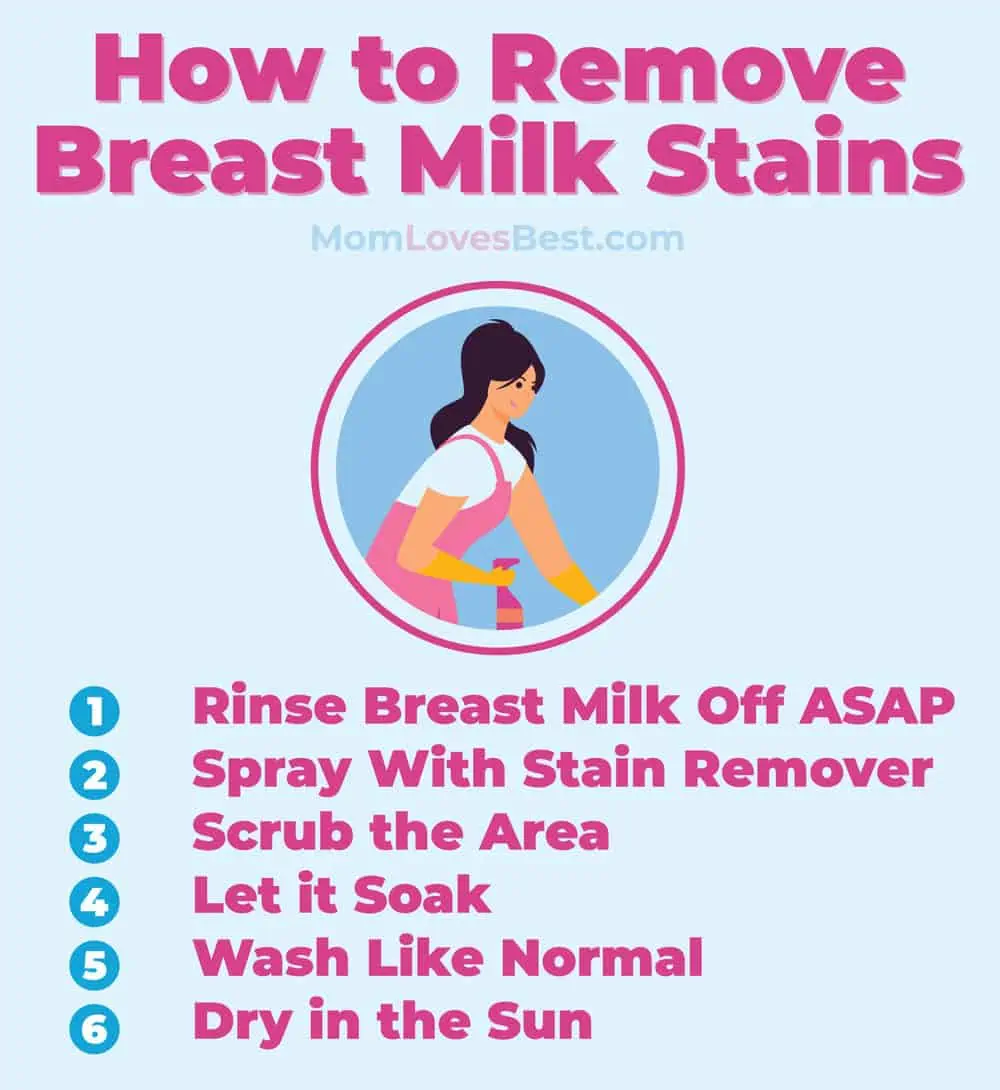Does your breast milk drip like a leaky faucet at all hours without consideration for your whereabouts or wardrobe? Are you wondering if your milk will cause stains or worried about how you’re going to get them out of your clothes?
Breast milk stains aren’t always visible in their early stages. They usually appear slowly over time and, once visible, can be difficult to remove — difficult, but not impossible.
We know what it’s like to pull maternity, nursing, or baby clothes out of storage and find those telltale yellowish breast milk stains. But we’ve also done our research and have won this battle. We’ve managed to remove those breast milk stains from our clothing.
We’ll discuss why breast milk leaves such prominent stains and review our favorite products for removal. We’ll share how you can avoid messes and give you our six simple steps to remove breast milk stains from clothing.
Key Takeaways
- Breast milk stains are usually protein-based, and they can be difficult to remove once they appear.
- To remove the stains, you can use a detergent and stain remover with enzymes, which can break down the proteins in breast milk.
- Avoid using bleach as it can cause health concerns and it may damage some fabrics.
- To avoid messes, you can use nursing pads and old blankets, and you can clean up accidents immediately.
Why Does Breast Milk Leave Such Prominent Stains?
As you’ll soon find out, breast milk is the gift that keeps on giving. You’ll find these prominent yellow stains on your baby’s clothes, burp cloths, and blankets from your baby spitting up breast milk.
Breast milk stains, much like blood, feces, and dairy products, are protein-based stains. They are caused by animal-based (or human-based) products or secretions.
Protein stains need to be treated promptly, kept away from heat, and require enzymes to break down (1).
Remember
Which Cleaning Products are Safe to Use?
It seems like there are a billion stain remover products on the market, but how do you know which are safe to use on your clothes, nursing attire, and baby clothes?
Whether you go for a natural or synthetic option is a personal choice, but no matter what, you should look for a product with the fewest allergens and irritants when using them on your baby’s clothes.
You’ll want to choose the mildest product possible that gets the job done, but you’ll also need a detergent and stain remover with enzymes to break down those stubborn proteins in breast milk. Enzymes attack stains by digesting the proteins (2).
Caution
Can I Use Bleach?
Oxygen color-safe bleach can also be effective in removing protein-based stains, such as breast milk, but it could cause some serious health concerns, especially when used around children. Bleach contains harsh chemicals that can irritate the nose, eyes, and skin and can even cause respiratory issues and skin burns (3).
Because of these risks, it’s probably best to avoid bleach when removing stains from your baby’s clothes.
How Can I Avoid Breast Milk Stains?
To avoid dealing with breast milk stains in the future, try some of these tips:
- Clean up accidents immediately.
- Wear nursing pads.
- Place an old blanket, towel, or T-shirt you don’t care about over your nursing pillow.
- Store your baby’s clothes in a container with good airflow.
- Use cold water at all stages of stain removal to prevent the stain from setting.
Six Simple Steps to Remove Breast Milk Stains From Clothing
Ready to get rid of those stubborn stains? Roll up your sleeves, put on some gloves, and follow these six simple steps for removing even the toughest of breast milk stains.
1. Rinse Breast Milk Off ASAP.
By rinsing spilled or leaked breast milk off as soon as you can, you will give your clothing the best possible chance at fighting off stains. Soak your garment in cold water to prevent the stain from setting.
It’s a good idea to carry an extra wet bag in your diaper bag so you can rinse your clothes off while you’re out and about.
2. Spray With Stain Remover of Choice.
Pretreating is the key to stain removal. After you’ve rinsed your clothing item, spray the stained area with a natural or synthetic stain remover of your choice.
Natural Stain Removers
If you want to limit your family’s exposure to harsh chemicals, you’ll probably want to use one of these natural stain removers:
- Buncha Farmers Stain Stick: This all-natural, environmentally-friendly stain remover is made with saponified coconut oil and borax. You can rub the stick directly on the stain or make a spray by grating the stick into hot water.
- Lemon juice: 100% real lemon juice is a great option for white clothing, as it has a natural bleaching action due to its acetic acid.
- Hydrogen peroxide: Hydrogen peroxide is an effective bleach alternative that works well even on the toughest of stains. Plus, it’s safe for the environment.
Synthetic Stain Removers
If you’re not overly concerned about chemicals and just want something convenient and effective, then one of these synthetic stain removers may work well for you:
- Fels Naptha Laundry Bar: According to some parents, Fels Naptha is stain removal magic. It’s not only an inexpensive way to pretreat stains, but it also has several other uses around the house, like treating mildew, cleaning your carpets, and making handmade soap.
- Medela Soap: This is usually used for bottles and pump parts, but it’s also great for nursing clothes.
- Biz: This stain fighter is loaded with enzymes, so it’s sure to remove a wide variety of stains. It can be used as a pre-treatment or added to the wash cycle.
- OxiClean Baby Stain Remover: OxiClean has earned a good reputation for getting stains out.
- Dawn Dish Soap: A squirt of Dawn can do just as good of a job as your typical stain remover.
3. Scrub the Area.
Gently scrub the stained area with an old sponge or a soft-bristled brush, like a toothbrush. I like to keep old toothbrushes just for this purpose, but you could also buy a pack at your local dollar store.
4. Let it Soak.
After you’ve pretreated and scrubbed the stained area, let it sit for at least 10-15 minutes or as directed on the stain remover bottle before throwing it in the wash. With most stain removal products, you can even just throw the item in the hamper and wash it a day or two later.
However, you would not want to do this with any soap-based product as the soap will most likely leave grease stains.
5. Wash Like Normal.
Be sure to use a baby-friendly detergent when washing any baby items. Choose a detergent with enzymes to break down breast milk stains and avoid ones with fabric softeners, dyes, and perfumes.
With protein-based stains like breast milk, it’s best to avoid heat at every stage of removal, so be sure to machine wash the garment on cold or cool, following the manufacturer’s instructions.
6. Dry in the Sun.
The sun acts as a natural bleacher, so lay your clothes outside to dry if you can. If you live in a colder climate and this isn’t an option, let your clothes sit near a window for a few hours after drying them.
If your clothing has colors and prints on it, you may want to limit the time in the sun or turn them inside out while drying to avoid fading.
If you plan to throw your garments in the dryer, be sure to check for any remnants of the stain first. You’ll want to avoid heat and rework the stain if it’s still there; otherwise, it will set in.
FAQs
Bye-Bye, Breast Milk Stains!
Breast milk stains can create quite a headache for moms. These protein-based stains can be difficult to remove as they require direct action and enzymes.
But don’t give up on those hand-me-downs yet. You can remove breast milk stains from clothing by following the steps above.
Before you know it, those yellow-spit-up stains will be gone, and your clothes will be looking as good as new!









